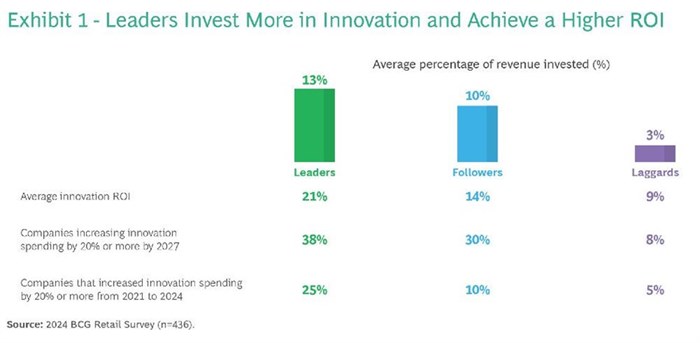Retailers have been warned that they need to innovate more or stand a chance to lose a seat at the top table.
Over the course of the last three decades, the composition of the top global retailers has seen significant churn, with few managing to maintain a lead position. Established players have been usurped by creative newcomers that have prioritised innovation, staying ahead of the curve in terms of technological advancements and changing consumer preferences.
A new study by Boston Consulting Group (BCG) and World Retail Congress (WRC), launched at World Retail Congress 2024, detailed how retailers can successfully ignite their innovation engines.
Retailers leading the way in innovation are investing an average of 13% of annual revenue in innovation initiatives and seeing a 21% ROI for their efforts, according to the report, Investing in the Future: How Retailers Use Innovation to Gain an Edge.
By contrast, retail laggards invest an average of only 3% of revenue in innovation and get a 9% ROI. As a result, laggards often fall into a vicious cycle where lower investment in innovation pilots is insufficient to drive a step change in performance and results in lower ROI, which in turn leads to further reductions in funding for innovation.
The report, which surveyed more than 400 senior leaders across 11 retail sectors, also revealed that innovation leaders are prioritising investments in three areas: operational improvements (71%); e-commerce (60%); and big data, AI, and analytics (58%).
What’s more, the report found that leaders aren’t afraid to be bold in their approach to innovation: they invest in multiple innovation projects at once, partner with third parties on innovation initiatives, and seek to shape consumer preferences rather than simply react to trends.
Nate Shenck, BCG’s global head of retail, said, “Even in a year of uncertainty with many focused on delivering on the basics, continual innovation remains crucial for retailers to maintain competitive advantage. You have to fight on a weekly, daily, and hourly basis to maintain it.”
Innovation leaders’ top priorities for e-commerce spending
Within e-commerce, innovation leaders are investing in three primary areas: marketplaces, retail media, and social commerce.
Consumer demand for convenience has driven the rapid growth of marketplaces, which offer a wide selection of products under one roof. In fact, marketplaces now account for 67% of global e-commerce sales.
Zak Haeri,
NielsenIQ 24 Apr 2024 Thus, to respond to customer needs and defend against digital pure-play models, 42% of innovation leaders in retail have invested in marketplaces, which offer retailers the ability to quickly scale their product offering with very low incremental investment and limited operational complexity.
Retail media has emerged as a game-changer, providing those who have embraced it with a new high-margin revenue stream. More than four in ten (44%) innovation leaders surveyed said they have invested in retail media—and opportunities for retail media networks are expected to keep growing in the next three to five years.
Looking to leverage retailers’ rich customer data, three-quarters of brands and suppliers already invest at least part of their marketing budgets in retail media offerings, and two-thirds expect to expand those investments in the near term.
Social commerce is already prevalent among retailers in the East. In China, for example, social commerce accounts for one in five e-commerce purchases.
Now, social commerce is also gaining momentum in the West, with platforms like Instagram and TikTok introducing commerce features to enhance engagement. Of the innovation leaders surveyed, 39% have made investing in social commerce a top three priority in recent years.
Driving the innovation engine
The report concludes that the most successful innovators in retail, classified as “leaders,” share six key success factors:
Ian McGarrigle, chairman of World Retail Congress, added, “This report clearly shows that the rules of engagement of have changed irrevocably. Unless retailers are willing to embrace their role as media owners, content providers, and trendsetters, they cannot hope to compete in a world in which traditional consumer loyalty has all but evaporated.”





































